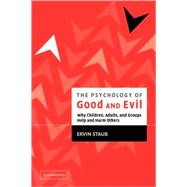
Note: Supplemental materials are not guaranteed with Rental or Used book purchases.
Purchase Benefits
What is included with this book?
| Part I. Introduction and Core Concepts: 1. Introduction: good and evil: themes and overview | |
| 2. Studying the pivotal role of bystanders | |
| 3. Studying and promoting altruism and studying and working to prevent genocide: the guiding role of early survival | |
| 4. Is evil a useful concept for psychologists and others? | |
| 5. Basic needs and their role in altruism and aggression | |
| Part II. The Roots of Helping and Passivity: 6. Helping a distressed person: social, personality, and stimulus determinants | |
| 7. Spontaneous (or impulsive) helping | |
| 8. Social and prosocial behavior | |
| 9. The power to help others: report on a Psychology Today survey on values, helping, and well being | |
| Part III. How Children Become Caring and Helpful vs. Hostile and Aggressive: Section 1. Culture, Socialization, and Children's Experience: 10. Origins of caring, helping, and nonaggression: parental socialization, the family system, schools, and cultural influence | |
| 11. Natural socialization: participation in positive behavior and experiential learning | |
| 12. The origins of hostility and aggression | |
| 13. Cultural societal roots of violence: youth violence | |
| 14. Bystanders and bullying | |
| 15. Students' experience of bullying and other aspects of their lives in middle school in Belchertown | |
| 16. Self-esteem and aggression | |
| 17. Father-daughter incest | |
| Section 2. Interventions to Reduce Aggression and Promote Caring and Helping: 18. Reducing boys' aggression: learning to fulfill basic needs constructively | |
| 19. The Caring Schools project | |
| Part IV. The Origins of Genocide and Other Collective Violence: 20. A note on the cultural societal roots of violence | |
| 21. Psychology of bystanders, perpetrators, and heroic helpers | |
| 22. Steps along a continuum of destruction | |
| 23. The SS and the psychology of perpetrators: The interweaving and merging of role and person | |
| 24. The origins of genocide: Rwanda | |
| 25. Bystanders as evil: the example of Rwanda | |
| 26. Individual and group identities in genocide and mass killing | |
| 27. Mass murder: origins, prevention, and US involvement | |
| 28. When instigation does not result in mass murder | |
| 29. Persian Gulf Conflict was reflection of stormy undercurrents in US psyche | |
| 30. Mob violence: societal-cultural sources, instigators, group processes, and participants | |
| 31. Understanding and Preventing Police Violence | |
| Part V. The Aftermath of Mass Violence: Trauma, Healing, and Reconciliation: 32. Preventing group violence | |
| 33. Kosovo: the need for flexible bystander response | |
| 34. The effects of violence on groups and their members | |
| 35. Healing, reconciliation, and forgiving after genocide and other collective violence | |
| 36. Healing, forgiveness, and reconciliation in Rwanda: project summary and outcome | |
| 37. Further avenues to prevention | |
| 38. Commentary: human destructiveness and the refugee experience | |
| 39. A vision of holocaust education in holocaust centers and schools | |
| 40. Out of hiding | |
| 41. Review of: Legacy of Silence: encounters with children of the Third Reich | |
| 42. What can we learn from this tragedy?: a reaction days after September 11th, 2001 | |
| Part VI. Creating Morally Inclusive Societies: 43. Transforming the bystander: altruism, caring, and social responsibility | |
| 44. Changing cultures and society | |
| 45. Blind vs. constructive patriotism: moving from embeddedness in the group to critical loyalty and action | |
| 46. Manifestations of blind vs. constructive patriotism: summary of findings | |
| 47. The ideal university in the real world | |
| Conclusion: 48. Creating caring societies | |
| Appendix: what are your values and goals? |
The New copy of this book will include any supplemental materials advertised. Please check the title of the book to determine if it should include any access cards, study guides, lab manuals, CDs, etc.
The Used, Rental and eBook copies of this book are not guaranteed to include any supplemental materials. Typically, only the book itself is included. This is true even if the title states it includes any access cards, study guides, lab manuals, CDs, etc.